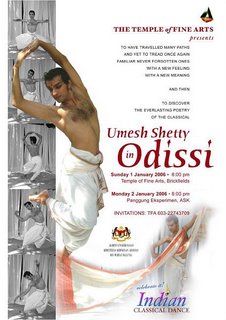
MANY may have heard of Umesh Shetty and his experimental contemporary dance initiative, Inner Space, which featured the performance Inside Out last May. Now, just months later, what has led him back to the classical form?
Tonight, Umesh will kick-start the Temple of Fine Arts’ celebration of 25 years of dance and music with Umesh Shetty in Odissi, his first solo Odissi presentation. He will reveal his prowess as an Indian classical dancer in a five-piece traditional repertoire, under the creative direction of Geetha Shankaran Lam.
Born into a family of dancers, Umesh grew up watching his parents perform, and tagging along when they toured. His father, the late Gopal Shetty, was a pioneer dancer with the Temple of Fine Arts (TFA) when it was formed in 1981.
At 10, Umesh studied Bharatanatyam under his father; he also picked up a bit of Kathakali and Manipura from him. In 1991, he went to India to study Khatak with Rohini Bhate (for three months). A year later, he started his Odissi training with Geetha.
In 1994, he left for Australia to pursue a Bachelor of Arts in Dance at Edith Cowan University. There, he studied ballet, contemporary dance and choreography.
“When I returned to Malaysia in 1997, I had the idea of fusing dance from the East and West. As I became more mature, I begin to see dance as a means of expression, and our body, an instrument. The aim is not to bring Malay or Chinese dance into a piece of work. Rather, if a certain movement from a different dance form can express an emotion, story or character better, then it makes sense to use it.”
Maturity has also changed Umesh’s approach to Odissi. Before, it was just about getting the steps and sequences right. Now, he feels he has more freedom to play around with the steps.
As far as classical Indian dance goes, Umesh believes that dance is a prayer. The dancer forgets himself in meditation and takes on the role that he is dancing.
And what about Geetha’s hand in creative direction?
“As her student since 1992, I have seen her style change; it is still evolving as she strives to define her own style,” Umesh replied. “Geetha was one of Ramli Ibrahim’s first few graduates. There are two main styles in Odissi. Ramli comes from the Deba Prasad school (a masculine style).
“Kelucharan Mohapatra, whose style is more feminine, led the other school. When Kelucharan came to Malaysia in 1998, he stayed with Geetha for a few weeks and imparted knowledge to her. May I add that dancers from all over India would die to spend just one hour with the legendary Kelucharan.
“That’s how it is with classical Indian dance. Someone contributes to an art from and someone else takes it further. Geetha is combining the Deba Prasad and Kelucharan styles and exploring how far she can take the merger. It’s an on-going process and it is exciting to see what it will evolve into.”
No comments:
Post a Comment